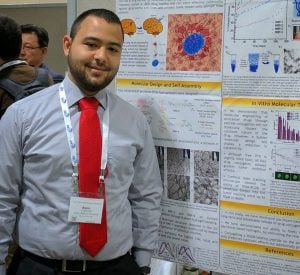
Brain tumors present special challenges for treatment because the blood-brain barrier, the protective mechanism that keeps most substances carried by the blood from entering the brain, prevents sufficient concentrations of systemically delivered drugs from reaching the tumor site.
 But a hydrogel that third-year PhD candidate Rami Chakroun is working on has the potential to sidestep this challenge by delivering the drug directly to the tumor site. In this “local” treatment approach, a cancer drug is paired with a peptide that causes it to form a nanofilament-based hydrogel when aged in water. This substance is then placed in the cavity left behind when the tumor is surgically removed from the brain. Chakroun’s team can even tweak the peptide sequence to control the drug’s release within the tumor site. The only other currently available local treatment distributes the drug over a period of about five days, but Chakroun and his colleagues achieved a 22-week release rate in the lab, ensuring steady exposure over a much longer period.
But a hydrogel that third-year PhD candidate Rami Chakroun is working on has the potential to sidestep this challenge by delivering the drug directly to the tumor site. In this “local” treatment approach, a cancer drug is paired with a peptide that causes it to form a nanofilament-based hydrogel when aged in water. This substance is then placed in the cavity left behind when the tumor is surgically removed from the brain. Chakroun’s team can even tweak the peptide sequence to control the drug’s release within the tumor site. The only other currently available local treatment distributes the drug over a period of about five days, but Chakroun and his colleagues achieved a 22-week release rate in the lab, ensuring steady exposure over a much longer period.
Brain tumors are usually aggressive, so the researchers don’t expect the new treatment to save lives, but hope it can extend them. “I wouldn’t say it will be able to cure glioblastomas, but you never know in the future. The goal is to enhance life expectancy,” Chakroun says.
Chakroun, a native of Lebanon who grew up in Kuwait and earned his undergraduate degree in biological engineering at Purdue University, won a National Science Foundation graduate research fellowship in 2017. He’d always been interested in research, completing two years in college along with several medical internships. While investigating doctoral programs in chemical engineering, he learned of the ChemBE hydrogel project and was immediately hooked; his two neurosurgeon uncles quickly expressed their interest too.
Following another family tradition, Chakroun loves teaching as well as research and, looking toward the future, hopes to blend the two in an academic setting like his father, a professor of mechanical engineering at Kuwait University. The combination is powerful, Chakroun says; “you’re generating new knowledge through research and teaching others at the same time.”
For academia, he has a role model in his lab’s PI, who he says has helped him to grow as a scientist and a person by making himself available to his students while also giving them broad independence. “He wants you to succeed more than himself, so he’s always telling you what the research impact might be later on,” Chakroun says. “Showing students the impact they’re having can encourage them to do big things.”